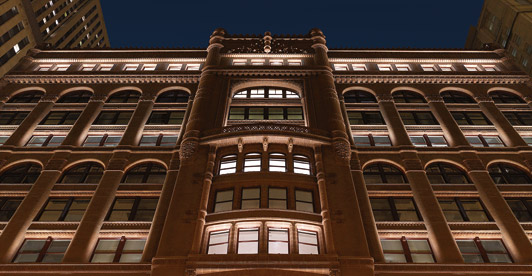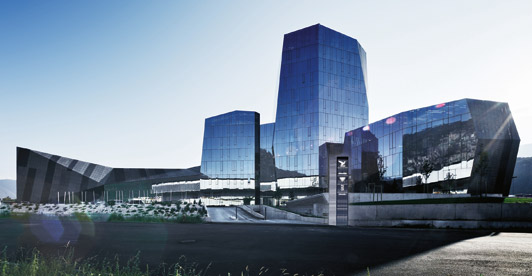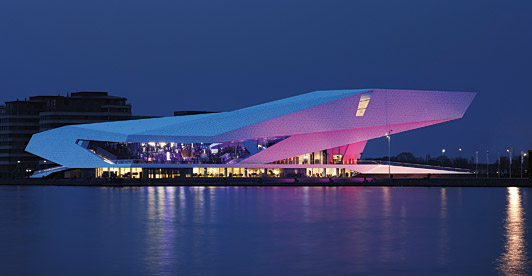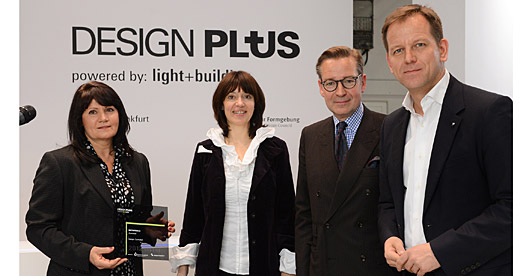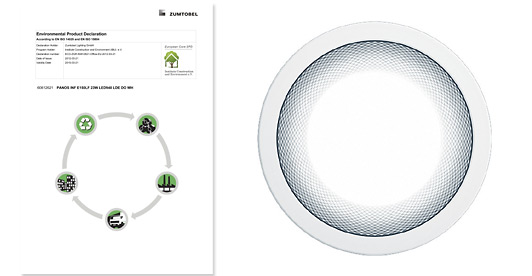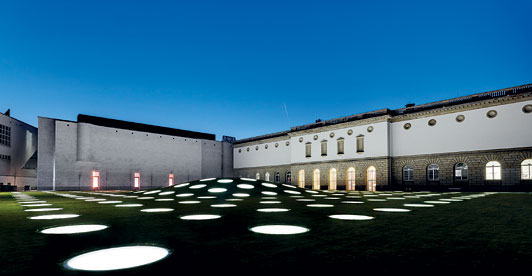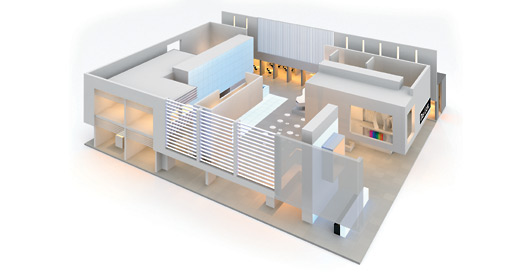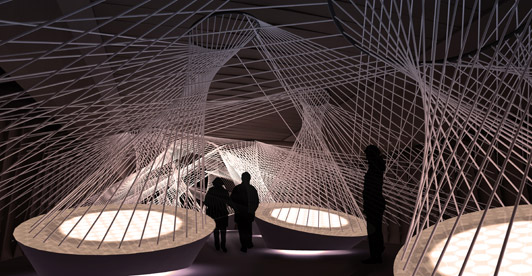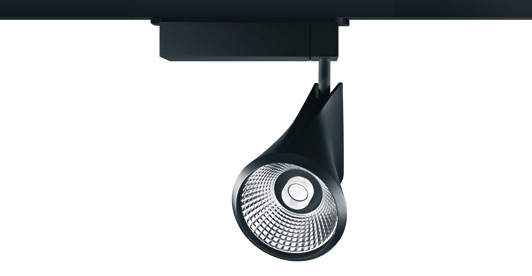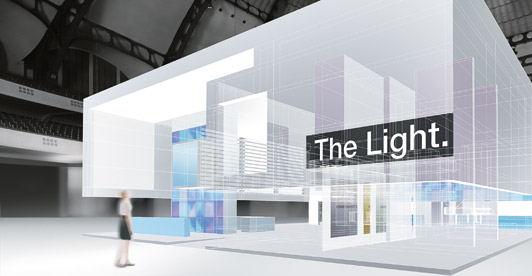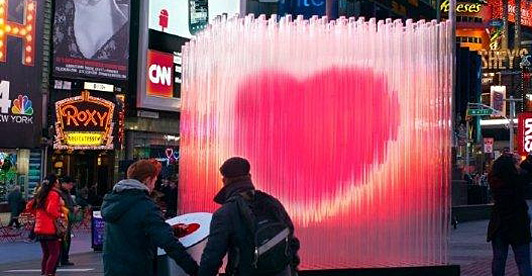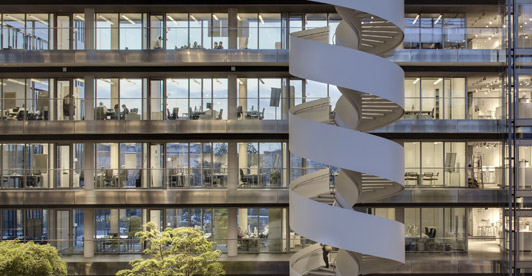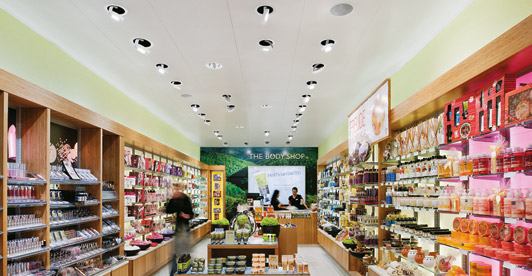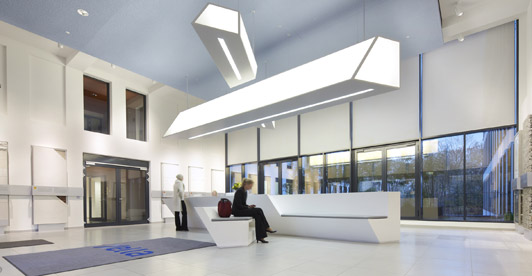Press Contact
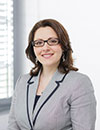
Press information 2012
-
12/2012Event
Zumtobel illuminates Mariko Mori artwork at the Royal Academy
From 13 December 2012 until 17 February 2013, the exhibition “Rebirth” by Mariko Mori will be on display at the Royal Academy in London.More informationLess informationThis is the first large-scale museum exhibition in a long time that is dedicated to the Japanese artist, who lives in New York. The subtle illumination of Birds, Drawing Room and Ring has been achieved thanks to the support of Zumtobel, a leading international supplier of integral lighting solutions. “The creation of my work, and the way in which it is seen and engaged with, is wholly supported by Zumtobel lighting. The light touches the surface, giving it a magical effect. I am deeply honoured and grateful for Zumtobel’s commitment to my work, a relationship that has been continual since 2003. Their technology and expertise are beyond my imagination.” says the artist Mariko Mori.
Zumtobel lighting solutions are based on a profound understanding of the effects of light. Espe-cially in museums, lighting is an important aspect. It creates worlds of experience, highlighting and enhancing the presentation of exhibits with public appeal. Last but not least, lighting experiences always represent a piece of culture, a piece of art.
Using a variety of media and forms of presentation, the exhibition “Rebirth” illustrates the various stages in a life cycle. In addition to newly created pieces, some of Mori's best known works such as the giant glass monolith Tom Na H-lu II (2006), which is illuminated by hundreds of LEDs, will also be on display.Zumtobel. The Light.
Photo: Richard Learoyd-
share it
-
-
11/2012Products
DISCUS evolution to achieve new top performance
The youngest member of the DISCUS LED spotlight range by Zumtobel creates impressive accents through minimalist design, high efficiency and low power consumption.More informationLess informationThe DISCUS LED spotlight range has been a big success ever since its introduction and has been very popular thanks to its flexibility, design language and innovative features. Now, with DISCUS evolution, Zumtobel continues this success story. The LED spotlight range is convincing on account of the perfect adjustment between light source and optic, making the lines of the spotlight appear even more advanced and minimalistic. The spot's innovative thermal management using a passive cooling system is an integral part of the design. The design of DISCUS evolution was created by the internationally famous Vienna-based design studio "EOOS"; it was developed such that the four different lens optics - Spot, Floor, Wideflood and Oval, with colour temperatures of 3000 K to 4000 K - can be replaced quickly without any tools. Apart from this flexibility, the directly dimmable spotlight is characterised by its excellent colour rendering and its low energy consumption. DISCUS evolution is available with a black or white housing, and it is suitable both to be installed on tracks and for recessed installation. Facts & figuresApplication Ideal for premium accent lighting, especially in retail spaces and presentation areas Mains voltage
220–240 V / 50/60 Hz Colour temperature 3000 K (LED830/930: warm) or 4000 K (LED840: intermediate)
Colour rendering
Ra 82 (LED830/840) / Ra 92 (LED930)
Colour constancy MacAdam 3 (1/16 – 2/16 ANSI Bin) Luminous flux of luminaire 1800–2400 lm Luminaire efficiency
56-71 lm/W
Service life
50,000 hours at 70% luminous flux
Colour
mat black or white microstructure paint
Zumtobel. The Light.
-
share it
-
-
11/2012Products
XPO for more efficient shelf lighting
With the smallest LED shelf lighting system currently available, Zumtobel once more emphasises its pioneering role in the efficient and authentic presentation of goods.More informationLess informationThe precise, authentic lighting of goods is part of the high art of illuminating retail spaces. The requirements are very high. LED luminaires are meant to put the products in the right light authentically and at the same time gently, while they ideally ought to disappear in the shelf and to offer various colour temperatures. XPO easily meets all these demands. The smallest, delicate LED shelf lighting system offered by Zumtobel is only 7 mm high and 11 mm wide. These dimensions are an important prerequisite for XPO luminaires to fit into the shelf unnoticed. The small size and Plug&Play technology of XPO offer a maximum of flexibility: it is available for shelves of 600, 1000 and 1200 mm, providing premium-quality, authentic illumination for any product through brilliant LED light combined with a specially developed shelf lighting optic. Individ-ual lighting with different colour temperatures is especially important in shelf lighting. Therefore, XPO is available both in the Stable White version (colour temperatures 2700 K, 3000 K, 4000 K, and 5000 K) and in the Selectable White version, where the colour temperature can vary between 3000 K, 4000 K or 5000 K as required. Another strong point of the LED shelf lighting system is its quick, no-tool installation and its high efficiency of up to 72 lumens per watt. All this together with its long service life make XPO an efficient solution for the presentation of goods in supermarkets.Facts & figures
Application LED shelf lighting system for professional high-quality illumination of products on shelves XPO Stable White
Versions with 2700 K, 3000 K, 4000 K and 5000 K ready-to-connect incl. white 2-pole 0.75 mm2 cable (0.7m long) and plug-in connection
XPO Selectable White Three different colour temperatures in one single luminaire
Switchable between 2700 K, 3000 K, 4000 K and 5000 K ready-to-connect incl. white 2-pole 0.75 mm2 cable (0.7m long) and plug-in connection
Lengths
545 mm, 923 mm and 1112 mm
Service life 50,000h at 80% luminous flux Zumtobel. The Light.
-
share it
-
-
11/2012Products
SFERA with SWARMCONTROL
The first LED free-standing lu-minaire featuring collective intelligence
Flexibility and adjustability are fundamental requirements with respect to optimal lighting quality at the workstation. With the SFERA LED free-standing luminaire and SWARMCONTROL technology, Zumtobel has created yet another milestone in innovative office lighting.More informationLess informationGood lighting at the workstation is extremely important. After all, perfectly adjusted lighting provides for greater well-being, increased productivity and better communication at the workplace. With the SFERA free-standing LED luminaire, Zumtobel sets new standards in this area - especially with respect to adjustability and individual lighting quality. Yet SFERA offers more than just perfect lighting. Its energy efficiency is impressive, too. This is made possible through a combination of SENSCONTROL III - the latest version of adaptive lighting management by Zumtobel - and the innovative SWARMCONTROL technology that is used for the first time in this free-standing luminaire.
SWARMCONTROL
More flexibility and even more personalised light - those are the most outstanding features of the pioneering SWARMCONTROL technology by Zumtobel. This technology automatically configures the luminaires into a swarm or cloud. Without any additional software. Even if the arrangement of workstations in the office changes, SWARMCONTROL provides for quick and easy adjustment to altered room layouts.
Apart from this unique feature, two functions are characteristic of SWARMCONTROL: the corridor function and the presence-based function. The first primarily provides for safety and orientation: by means of built-in presence detecttor the luminaires are dimmed up one after the other, indicating the way to the workstation. The presence-based function, on the other hand, ensures ideal lighting conditions with a mean illuminance level of up to 500 lux at the workstation, while the quantity of light can be adjusted to individual needs at any time. Additionally, depending on the available amount of daylight and artificial light, a lighting cloud is formed following a radio signal to neighbouring luminaires, ensuring an optimal, pleasant room ambience, at the same time offering more visual comfort for the various tasks in hand.
What is more, SFERA guarantees glare-free work at the computer screen or tablet PC owing to its patented MPO+ optic. With light quantities of around 6300 lumens, a low installed load of 70 W and an LED service life of up to 50,000 hours, and with its high-grade material finish, the luminaire em-phasises its high standard of efficiency and sustainability.
Facts & figuresLight distribution Free-standing LED luminaire with separate, self-contained lighting chambers and asymmetrical direct/indirect light distribution
Indirect/direct light distribution: 54:46
Optic Transparent plexiglass cover made of PMMA with integrated MPO+ light control technology (micro-prism optic in multi-layer design) as well as defined light emission and glare control according to EN12464 Built-in control system
SENSECONTROL III
SWARMCONTROLLuminaire head dimensions 650 x 420 x 34 mm
Stand dimensions
45 x 70 mm
Height/luminaire 1,950 mm Service life 50,000 hours at 70% luminous flux Zumtobel. The Light.
-
share it
-
-
08/2012Event
Zumtobel is a partner of the 13th Architecture Biennale in Venice
More informationLess informationFor Zumtobel, collaborating with architects and designers has always been a top priority; this is why the Austrian luminaire manufacturer is involved this year again as a sponsor of the 13th Venice Architecture Biennale. The Austrian luminaire manufacturer has been a partner of the most important international architecture exhibition since 2002. David Chipperfield, director of the 2012 Architecture Biennale, appreciates this support: “Contributions by companies like Zumtobel are of great importance when implementing an Architecture Biennale that meets our high demands in terms of quality. Thanks to our sponsors, we were able to consider all the high-quality projects submitted for presentation, and can now show the effects of modern architecture in society.”
Moreover, Zumtobel has supported two contributions to this year's Biennale. Jointly with Reflexion, a Zurich-based lighting design studio, Swiss architect Peter Märkli has staged an exhibition displaying sculptures by the artists Hans Josephsohn and Alberto Giacometti. In the process, Märkli considered it of particular importance for the sculptures to become part of the room. For this purpose, conventional exhibition lighting was not sufficient, but an integral spatial concept was required. Zumtobel luminaires in white and blue allow individual colour mixes and adjustment of the lighting scenes, so that the three-dimensionality of the walls and sculptures can be emphasised to special effect.
A French project, too, was implemented using lights by Zumtobel. The Wilmotte Foundation invites visitors to discover the “FondacodegliAngeli” and presents the exhibition “Re-Generation Venezia”.
With its commitment to the Venice Architecture Biennale, the Austrian company emphasises once again the importance it attaches to addressing the topics of light, architecture and art to boost innovation and creativity.
Zumtobel. The Light.-
share it
-
-
08/2012Lighting Solution
Opening of Zumtobel Lighting UK Light Centre
Zumtobel Lighting’s move to upmarket Chalfont St. Peter in the county of Buckinghamshire, involved the construction of one of Zumtobel's most modern and inspirational Light Centres, covering an area of 340 m2. Easily accessible from London, the new Light Centre is not only a showcase for a comprehensive range of lighting solutions, it is also a place to meet lighting professionals and those with a passion for light and architecture.More informationLess informationZumtobel presents trend-setting lighting solutions for various application areas in 18 Light Forums and Light Centres around the world. In Chalfont St. Peter, visitors can learn about innovative lighting application techniques and the inno-vative luminaires that aid intelligent lighting designs, through application spaces, known as ‘App Spaces’. Besides personalised advice, emphasis is always placed on experiencing light as a medium.
First daylight showroom
The Zumtobel brand is inextricably associated with aesthetically attractive de-sign and a clear stylistic idiom. This purist design flare is evident at the Chalfont St. Peter Light Centre where Zumtobel’s full lighting design concepts and capa-bilities are featured. Highly atmospheric centre-stage settings and selective ac-cent lighting, allow visitors to experience the ways in which light can be used to create the right atmosphere and ideal lighting conditions in different situations. The emphasis is on presenting lighting solutions using the latest cutting-edge LED technology which combine energy saving with lighting comfort.
The design concept of the Light Centre demonstrates Zumtobel's lighting exper-tise and knowledge of the uses of light. It also includes a vast array of distinctive features including, the first daylight demonstration in which visitors can have first-hand experience of the interaction between daylight and artificial lighting.
Focusing on customers' needs
Austrian lighting manufacturer Zumtobel has operated its sales organisation in the UK for 26 years. Having been fortunate enough to provide lighting solutions to some of the most exquisite and iconic buildings all over the UK, Zumtobel aspires to drive innovation, market education and best practice lighting.
"The Light Centre is based on an application cube concept which allows us to provide hands-on presentations and demonstrations of our lighting design ideas to visitors for every application, including, offices, retail, education, health & care, art & culture and façades & architecture. Authentic staging makes it pos-sible to experience light and its effects in a completely unique way. This enables us to cater to the specific requirements of our customers and demonstrate al-ternative solutions", comments Steve Shackleton, Zumtobel Lighting’s Market-ing Director, describing this new facility and its capabilities. “Our new Light Cen-tre will help drive our concepts, innovations and education even further still. The Light Centre is a direct response to growing business and the need for extra space to demonstrate our lighting capabilities and our ability to deliver personal-ised customer advice.” he explains.
Zumtobel. The Light.-
share it
-
-
08/2012Lighting Solution
Aberdeen leads way with complete LED shopping experience
Zumtobel's custom-made lighting solutions inspire proprietors and visitors alike
The lighting concept for “The Bon Accord and St Nicholas Centre” in Aberdeen gave Zumtobel yet another opportunity to demonstrate its prowess when it comes to integral lighting solutions. The company also delivered extremely high levels of innovation, lighting management and cost efficiency with a unique LED luminaire look that blends perfectly into the existing architecture.More informationLess informationThe “Bon Accord and St Nicholas Shopping Centre” in the Scottish town of Aberdeen boasts 70,000 square metres of floor space and is a popular destination for numerous keen shoppers. Since its extensive refurbishment, this shopping paradise is also one of the first malls in the United Kingdom to feature an LED-only lighting solution so it is also bound to attract fans of integral lighting solutions. Colin Kennedy, Project Surveying Manager with the client Land Securities acting for owners Scottish Retail Property Limited Partnership explains: “We wanted to explore how the use of LED technology could improve the lighting levels, while also complementing the new finishes in the centre. We are extremely pleased with the result. We have lower maintenance costs, and we also have a balance between daylight and artificial light to give optimum energy consumption.”
Wallace Whittle who carried out an energy appraisal comparing the existing lighting to a lighting scheme utilising the Zumtobel LED luminaire proposal found that an annual saving of approximately 117’000 kW hrs, with a predicted annual carbon reduction of 49’000 kg CO2 could be realised. “The Zumtobel lighting solution proved to be the ideal fit for our vision for this project in order to deliver environmental improvements, enhance the shopping experience and reduce energy consumption.” explains Steve Bruce Senior Electrical Engineer at Wallace Whittle.
Tailor-made customer solutions
The clinching factor in Zumtobel winning the contract was the fact that the company was able to present a coordinated concept that embraced both architecture and lighting – and combined this with state-of-the-art standards such as using LED luminaires and lighting management systems. Intensive discussions between architects, electrical designers and Zumtobel ensured optimum integration into the existing design and made sure that the LED technology inside the luminaires delivers the best possible lighting comfort. The development team met on-site in the United Kingdom several times in order to take a close look at the luminaires.
Graeme Nicholls from Gareth Hoskins Architects' explains: “We were pleased to work in close collaboration with Zumtobel to design a series of bespoke circular LED lights. Through a series of workshops, the design intent was discussed and a number of prototype fittings were developed in order to ensure that the final product exactly met the technical and aesthetic aspirations.” Thanks to square LED luminaires from the Careena product range, which were precisely adapted to fit the 481 mm round cut-outs in the shopping centre's ceiling, Zumtobel managed to pull off a unique luminaire look. These advanced LED luminaires also save considerable energy thanks to their low installed load and Zumtobel's specially developed MPO+ micro-pyramidal optic. The plain, uncluttered stylistic idiom of the Careena custom solution creates a timeless vista.
Lighting solution specialist Zumtobel developed another custom solution for the Resclite LED spots. Usually, these LED spots are used to guide visitors safely away from danger in the event of an emergency. In Aberdeen, however, these small LED power packages are also used to provide highlighting in everyday use. Specially tailored to fit a ceiling panel size of 31 mm, these round spots brighten up the shopping centre's roof with brilliant lighting accents, thereby creating the impression of a starry sky. As well as these two custom solutions, various standard Zumtobel LED products are also used in public areas. Light lines and downlights, for instance, provide varied ambient lighting. They make it easier for people to find their way around and facilitate shopping trips in a cosy, bright ambience.
Quality and service in a single package
Zumtobel was again able to successfully put its expertise in deploying high lighting quality and exploiting its effect on people to the test in Aberdeen. Implementing an efficient concept for saving energy ultimately makes this lighting solution a unique combination. The client opted to use Zumtobel's Luxmate Professional lighting management system in order to make the best possible use of daylight and artificial lighting. This intelligent system makes it possible to dim and control the LED luminaires efficiently and even program lighting scenes that mimic natural changes over the course of the day. This way, the right lighting ensemble is always available at the press of a button during opening hours, when cleaning takes place, and also at night.
Zumtobel. The Light
Client: Scottish Retail Property Limited Partnership, a joint venture between Land Securities and British Land Architects: Gareth Hoskins Architects, Glasgow/UK
Electrical consultants and installations: Wallace Whittle, Aberdeen/UK Lighting solution:
» Careena LED luminaires – custom solution
» Panos Infinity LED downlights
» Slotlight LED RGB light lines
Decoline light lines
» Micros downlights
» Resclite emergency lighting – custom solution
» Hedera façade luminaires
» Lighting control: Luxmate Professional
Copyright: www.nealsmith.com-
share it
-
-
07/2012Lighting Solution
More than 80% of energy saved thanks to LED light lines used for corridor lighting
The Public Works Department of Zurich's City Council conducted a pilot measurement project together with Eteam GmbH and Zumtobel. The lighting in two identical corridors in the Zurich-based Werd Administrative Centre was investigated to establish the potential energy savings that can be obtained using LEDs and optimised presence-based control. The result at the end of the four-month measurement period: LED lighting operated in the most energy-efficient mode can save more than 80% of energy, compared to conventional fluorescent lamp technology.More informationLess informationFor the pilot project, one of the two corridors remained unchanged: the conventional fluorescent lamps were switched off by presence detectors as soon as there had been no one in the corridor for more than ten minutes. The other corridor was fitted with innovative Slotlight LED luminaires by Zumtobel. In addition, the switch-off delay of the presence detectors was reduced down to one minute in several stages. In the case of LEDs, frequent switching or dimming has no adverse effects on lighting comfort and causes no wear. The measured power consumption of the LED solution with optimised presence monitoring was 81% less than that of comparable luminaires fitted with fluorescent lamps.“The result of the pilot project shows that LED technology combined with appropriate lighting control allows for huge potential savings and is by far superior to current standard corridor lighting concepts that are also deemed to be energy-efficient”, explains Daniel Cathomen, Zumtobel Marketing Manager Switzerland, further adding: “A combination of appropriate light sources and a finely tuned lighting management system therefore creates innovative, energy-optimised, future-proof lighting solutions that are highly acceptable to users and have short payback periods.”
Zumtobel. The Light.
-
share it
-
-
07/2012Lighting Solution
Great lighting art for great sports
In collaboration with Italian artist Monica Bonvicini, Zumtobel endows London with a work of lighting art.
For a long time, luminaire expert Zumtobel has been involved in the areas of art and culture, supporting the lighting visions of renowned artists. Collaborating with internationally renowned artist Monica Bonvicini, Zumtobel has created a unique lighting installation to be admired in London this summer.More informationLess informationThis summer, we will witness athletic excellence in London. Zumtobel, the luminaire manufacturer, will be represented in the City on the River Thames with an excellent performance as well. In collaboration with artist Monica Bonvicini, Zumtobel developed a huge permanent lighting sculpture titled “RUN”, which is on display at the London Olympic Park in front of the Handball Arena.RUN comprises three nine-metre tall letters, each weighing about 15 tonnes, which have been installed slightly offset, one behind the other, on the elevated plaza in front of the new Copper Box Handball Arena. The giant letters consist of mirror-coated glass panels mounted on steel structures. Hence, in daylight, the entire surface produces a mirror effect, and these ever-changing reflections of its immediate surroundings – the sky, the park, people, buildings – make the sculpture virtually dissolve, so that it seems to merge with its environment in a surreal way. When night falls, the sculpture's appearance changes: thanks to LED luminaires installed inside, along the outlines of the letters, and controlled by light sensors, the luminous letters clearly stand out against their environment. Convex mirrors installed on the inside and invisible in daylight transform the individual LED strings into a scintillating mass, which conveys to the structure an unexpectedly strong, yet light-weight spatial presence. Indeed, both the “elegantly psychedelic effect at night” (Monica Bonvicini) and the dissolution due to the mirror effect by day form a striking contrast to the sheer size and massiveness of the letters.
In order to implement Bonvicini's artwork, Zumtobel collaborated very closely with the artist, making every effort to turn her vision of the installation into reality. Completion of this unique task was facilitated by the years of experience and know-how Zumtobel has managed to obtain in the field of LED technology. Moreover, the luminaire manufacturer has also been involved in the area of art and culture for years. In addition to unparalleled lighting solutions developed for museums and exhibitions, Zumtobel has, over the years, collaborated with renowned designers, architects and artist such as Zaha Hadid, Daniel Libeskind, Olafur Eliasson and Hani Rashid within the context of the Zumtobel Masterpieces range. The aim of these collaborations, and also of Monica Bonvicini's “RUN” installation, is to put lighting ideas into practice and create unique luminous works of art.RUN fact box:
Artwork: Monica Bonvicini, Berlin Light design: Studio Dinnebier, Berlin
Steel/glass production: Sedak, Gersthofen Lighting solution: Zumtobel
High-power LEDs in plastic housing, IP 68, light colour: 7500 K, diameter: 16 mm, 8464 units in total
Zumtobel. The Light.-
share it
-
-
07/2012Company
Zumtobel “Map of Light” app now linked to product catalogue
With effect from this week, the Zumtobel “Map of Light” app includes more than 1000 accessible projects, and a new version upgraded for iPhone and iPad is available in the App Store.More informationLess informationWith effect from this week, the Zumtobel “Map of Light” app includes more than 1000 accessible projects, and a new version upgraded for iPhone and iPad is available in the App Store. The free app has been optimised for iPad 3, offering new services to users thanks to new functions. What is new is that Zumtobel's product catalogue including technical data for the entire product range is now available on the “Map of Light”.
On the “Map of Light” created by luminaire manufacturer Zumtobel, users can now easily and quickly access more than 1000 lighting solutions across the globe. All the information and pictures pertaining to any project can be seen at a glance, allowing users to search according to application area or project location. In this way, the “Map of Light” provides fascinating insights into the variety of lighting solutions and concepts available. At the same time, it is a very useful tool for lighting designers and architects: they can access current reference projects at any time, plus the products used for these and a picture gallery. In addition to the new link to the Zumtobel product catalogue, information on current Zumtobel product innovations can be found under Highlights. The application is available free of charge in the App Store at: » http://itunes.apple.com/gb/app/map-of-light/id397335153?mt=8
More than 1000 projects provide users with insights into the world of light
Project no. 1000 on the “Map of Light” is a special highlight: at the McLaren show-room in Vienna, Zumtobel demonstrates how light is used to set a special brand centre stage while meeting the highest requirements in terms of a sustainable lighting solution. The lighting concept provides the requisite degree of flexibility to adjust the lighting situation to the various exhibition situations and car models presented. In addition, trendsetting LED luminaires have been installed in order to increase energy efficiency while ensuring optimum lighting quality.
Zumtobel. The Light.-
share it
-
-
05/2012Lighting Solution
Marriot relies on convenient lighting management by Zumtobel
260 ZBOX lighting control systems for new hotel in Baku
The new 5-star JW Marriott Hotel in Baku offers both business and leisure travellers superb high-end comfort. Even the lighting seems to cater automatically for guests' preferences – thanks to a cutting-edge Zumtobel ZBOX lighting management system that is used in all the hotel's 243 room.More informationLess informationMany eyes will be fixed on Baku, the capital of Azerbaijan, on May 26, because this year Baku is hosting the 57th Eurovision Song Contest, Europe's largest music competition. Even without the Song Contest, Baku is an impressive city of 2 million inhabitants. The most populous and largest city in the entire Caucasus region is a transport hub as well as an economic and cultural centre that is home to various universities, research institutes, theatres and museums. No wonder the Marriott hotel chain has just opened a new 5-star hotel in Baku.
The JW Marriott Absheron Baku Hotel is located close to the city centre between futuristic office buildings and the historic old town. It offers its guests extremely high levels of comfort that meet every imaginable up-to-the-minute standard. This includes the lighting concept in the hotel rooms, which was implemented by luminaire manufacturer Zumtobel. Zumtobel won the contract to equip all 243 rooms and suites with its advanced ZBOX lighting management system.
ZBOX – Making it easy to control light
Peter Roos, Head of Strategic Global Networks at Zumtobel, explains: "With ZBOX we are able to supply hotel operators with a multifunctional, flexible, energy-saving lighting control system that also provides hotel guests with individual lighting scenes that they can recall at the press of a button. The actual guest decides which lighting ambience he or she wants and can adjust it to suit his or her needs. Zumtobel supplies the ZBOX lighting management system as an all-inclusive package – each complete with four innovative Circle control points and a central control unit. The system is fully pre-addressed – and comes with connectors for dimming, presence detection, door lock systems or blinds control.
Guests enjoy a care-free stay
The ZBOX's convenient features and benefits are obvious: guests in the contemporarily styled rooms of the JW Marriott Hotel are faced with intuitive control points rather than a bewilderingly large number of switches. Roughly the same size as a standard on/off switch, these Circle control points fulfil all the basic functions of a sophisticated control panel. To call up any of three programmed lighting scene, all guests have to do is press a button with the respective icon on it. The ZBOX then conjures up perfect lighting for applying make-up, watching TV, reading or taking a bath. Various lighting scenes can be generated equally straightforwardly and dynamically. "Our guests reap the benefit of the great flexibility and functionality of Zumtobel lighting as well as intuitive operation. This gives them a unique level of convenience that allows them to adjust the lighting themselves to suit their respective needs" points out Petra Maluck, International Project Management Marriott International Inc..
The central control unit, the ZBOX controller, is tuned to both the guest's lighting needs and the hotel operator's requirements: connectors for hotel card switches and door locking systems ensure a pleasant, inviting lighting scene when the guest enters the room. The ability to integrate the ZBOX into a modern building management system makes an intelligent contribution towards energy-efficient, low-cost operation of the hotel. Using ZBOX makes it possible to obtain energy savings of up to 25 % – not to mention greater lighting convenience for hotel guests.
Zumtobel. The Light.
Fact box:
Client:
Marriott International Inc. General contractor: Strabag, Vienna/A Developer:
PASHA Construction, Baku/AZ Architecture: ReardonSmith Architects, London/UK Interior design:
WA International, Dubai/AE Electrical consultants: EC Harris Lighting solution:
Zumtobel
ZBOX lighting management system
LUXMATE LRA2500 automation processor and LM-GO graphical visualisation-
share it
-
-
05/2012Company
LED lighting in art
On high-fidelity rendering of light
Author: Carina Buchholz, Lighting Application Management, Zumtobel Lighting
LED lighting: curse or blessing? For a long time, there had been rather fierce discussions about this topic. But in the end it was the positive experience obtained from practical application of the technology in museums and, among others, the ground-breaking scientific studies by Zumtobel that have removed final doubts about this milestone in the production of light. Light generated by semiconductors has finally entered the world of museums in 2012 and impresses above all with new prospects, such as the modification of light colours within a light source with very good colour rendering properties (Tunable White).More informationLess informationThe continuous dynamic development of optical semiconductor technology offers undreamt-of possibilities for the interaction between people and art objects. However, it also provides new challenges and opportunities for museum and lighting experts, and not only from a technical point of view. Lately, the discussion regarding LED technology has been dominated by two issues in particular: what chances do LED spotlights offer to present exhibits in the right light and, thus, to make a positive contribution to the perceptive world of visitors to museums? Are light-emitting diodes indeed a revolution in terms of damage pre¬vention to exhibits, or do they perhaps deprive future generations of their cultural heritage? Thanks to comprehensive research and studies, lighting expert Zumtobel has found answers to precisely these questions that are based on sound scientific knowledge.
Picasso brings it to light – the high quality of LEDs in museums
Zumtobel has commissioned the Lighting Tech¬nology Department of Darmstadt University of Technology to conduct a survey that deals with this very issue. Evaluation parameters of particular relevance for art objects were especially important. These include both the electrical and photometric properties of luminaires, including light colour, spectral radiation distribution, colour rendering, illuminance, potential damage, the electrical installed load and, above all, the uniformity with which the painting is illuminated, since this is a measure of the quality of presentation. Two spotlights (LED and halogen), an LED arc used for indirect lighting and an LED module were analysed in the laboratory. Following measurement, the damage potential of the luminaires according to CIE 157:2004 was evaluated. A field test should then confirm the determined values specifically for practical application.
For the field test, the study managers installed two different light sources, one after the other, directed onto Pablo Picasso’s drawing “Harlequin” from 1916. One spot was equipped with conventional tungsten halogen lamp technology, the other with LED light sources. In the LED luminaire, light colour and luminous intensity were set via a control system from 2700 K to 6500 K, or from warm white to cool white (Tunable White). The analysis of the halogen spotlight is also based on its dimmed and non-dimmed state. For the “Harlequin”, Picasso used a thin, lightly wavy paper attached to a heavy carrier paper. Since this technique, in terms of final composition, is most similar to rag paper, the characteristics of this type of paper were used by the study managers as a reference for evaluating the damage caused.
The results of the field study confirm Zumtobel's research work in the field of LED lighting. Basically, with comparable colour temperatures, potential damage caused by the LED spotlight in the laboratory is significantly lower; and this applies to all materials specified in CIE 157:2004 such as rag paper, textiles, water colours on paper rag as well as oil colours on canvas and newspaper. Due to the lower potential damage caused by LED spotlights, possible radiation duration with most materials can be increased by around 50 % and with newspaper by as much as 300 %. The measure¬ments performed on the Picasso drawing also confirmed these results. Only with higher colour tempera¬tures (from approximately 3250 K) do radiation times become comparable to the halogen lighting at 2050 K.
• The dimmed halogen spotlight generates white light with very low colour temperature, comparable to candlelight. Current supply must therefore be increased to create brilliant white light. The high illuminance generated in this way not only increased the potential damage, but also has a negative impact on the energy balance.
• By dimming the halogen spotlight to the required illuminance level, the light colour is shifted from 2900 K to 2000 K. This value impairs the stability of perception. With the LED spotlight, on the other hand, the illuminance level can be adjusted without the light colour being im¬paired.
• When it comes to colour rendering, both halogen and LED spotlights demonstrate very good values of Ra > 90. Only at higher colour temperatures such as 6500 K (cool white) is colour rendering reduced to Ra 84 in the LED spotlight. Colours are thus rendered similarly well with both lamp types.
• The evaluation of the illuminance levels has shown that the halogen luminaire illuminating the “Harlequin” shows irregularities that are also revealed to observers. This criterion must, however, not be overvalued, because the uniform presentation of a painting is not always aimed at. Instead, an exhibit can be properly presented with intentionally implemented bright/dark zones as well.
• Input of electrical energy with the LED spotlight is around 50 % less than with a halogen spotlight; in the undimmed range it is as much as 30 %, which may amount to decisive potential energy savings.
The benefits of light-emitting diodes, such as long service life combined with low maintenance, high energy savings potential as well as impressive and simultaneously gentle presentation of exhibits, are undisputed. Another important aspect, however, comes to the fore because of the Zumtobel study: thanks to innovative technologies, it is now possible to enhance the effect of art objects on people. LED light enhances the power of expression, since not only luminance levels but also light colours can be finely tuned to specific exhibits according to colour or material – by pressing a button and without the need to replace lamps.
A symbiosis of light and art – the Tunable White revolution
A painting with many fine grades of red will shine with its saturated colours and contrasts, but only if the light source as well as the selection and positioning of luminaires are perfectly matched to the prevailing ambient conditions. To achieve the best quality of perception, a light spectrum should be used for an art object that is characterised mainly by the long-wave, reddish spectral range, as light is able to reproduce those colours especially intensively and precisely that exist in its own spectrum.
When an art object is illuminated, the artist's colour selection, the location of creation and the lighting conditions prevailing at the time of creation (daylight or artificial lighting) must also be considered. These factors sometimes require completely different light colours and spectral distributions. This variation depth can, however, never be fully met by only one luminaire and lamp type. In practice though, often one spotlight or lamp type is used for an entire art gallery as a compromise solution with mean intermediate white light colour and very good colour rendering. A pioneering alternative in this regard has come from semiconductor technology. A widely defined, finely tuned light spectrum can be individually adjusted to each object via LED luminaires with identical design – at the press of a button, with outstanding colour rendering and with optimum luminance of the exhibit. With modifiable white light, i.e. variations in light intensities and colours (Tunable White), works of art with mainly bluish or reddish colours or different materials can be equivalently presented without the need to exchange the lamps or spotlights.
In this way, a museum is ideally equipped for the future: when exhibitions are changed, the light is quickly adapted to new art works according to the wishes of the artist or curator and with relatively low maintenance effort. The lighting can be finely tuned in a way that was technically not feasible until recently. Using modifiable white light emitted by the same LED lighting solution, it is now possible to implement this quality of perception and equivalent display of art in a manner that can only be described in one word: perfection.
Incomparable: today's LED and yesterday's LED
However, another problem has resulted from the high development speed of semiconductor light sources: studies continue to be published that are based on obsolete technological standards, thus causing further uncertainty regarding colour rendering and potential damage with respect to LEDs.
Warm white LEDs demonstrate the lowest peak in the low-wavelength, high-energy range. They therefore have a lower damage factor than LEDs with a high blue component (cool white). LEDs with warm white light quality have recently progressed rapidly in terms of development with colour rendering and efficiency. In addition, spotlights incorporating Tunable White technology provide new approaches: luminaires with adjustable white light colours ranging from low to high Kelvin values, i.e. warm white to cool white, can be precisely adapted to exhibits in fine gradations along the Planckian curve. The lowest Kelvin value (warm white) is set in the case of highly sensitive works of art, without any losses in terms of the luminaires' very good colour rendering. Lighting concepts incorporating Tunable White thus offer a variety of options for perfect adjustment to the art object and the needs of human perception.
Adequate exposure to light – responsibility for the future
When discussing the potential damaging effects of light, in addition to spectral distribution, there are also other decisive factors of influence regarding lighting intensity and duration of exposure. For this purpose, Zumtobel provides also innovative solutions involving intelligent lighting management systems.
Lighting management ensures that exhibits are exposed to perfect light: on the one hand, by providing luminance levels that are necessary to ensure a good perception process and, on the other hand, by incorporating presence detectors that monitor the presence of visitors. Switch-on and switch-off times can be defined for specific times of the day. Management of blinds and daylight sensors ensures that only as much daylight is permitted to enter as is absolutely necessary, resulting in an ideal balance between architecture, human well-being, exhibits and energy costs.
Moreover, LED technology is the perfect solution to be integrated in lighting management systems. The semiconductors are not impacted by frequent switch-on and switch-off processes e.g. due to presence detection, or by frequent dimming. The desired lighting level is immediately available without annoying start-up times. In addition, undesired colour shifting or modification of the quality of colour rendering as may occur during dimming with conventional technology are not applicable with semiconductors, as is unrestrictedly confirmed by the study results of Darmstadt University of Technology.
This also means that the use of lighting management systems is an even more important topic to discuss than the subject of potential damage from LED lighting, for these systems help to save valuable energy without any limitations in terms of visual or emotional quality of light. Environmentally conscious art enjoyment and gentle exposure to light are thus harmoniously combined. In this way, museums that use resources sparingly and handle cultural assets gently can take responsibility in two ways, ensuring an authentic presentation of art works by implementing integral lighting concepts.
Zumtobel. The Light.
Image 2: ©TU Darmstadt, Image 3: ©Philipp Schoenborn Muenchen-
share it
-
-
05/2012Lighting Solution
And the winner is…
Rookery Building in Chicago wins 2012 WAN award
The Rookery Building in Chicago, which has recently been fitted with a new façade lighting solution by Zumtobel, is the winner of the 2012 WAN (World Architecture News) Award.More informationLess informationThe façade illumination of the Rookery Building in Chicago developed by the New York lighting design studio Office for Visual Interaction (OVI) and implemented by Zumtobel was awarded a prize as the best lighting solution. Because it is architecturally unique, the office building has been listed in the National Register of Historic Places since 1970. It is not just its interior, designed by Frank Lloyd Wright, that hides unique, fascinating architectural features. The façade of the high-rise, which is decorated with ornate stucco, is another aspect of this architectural jewel. The innovative and now prize-winning lighting system illuminating the building's unique masonry allows the Rookery to develop an elegant, low-key identity.
The custom LED luminaire specially manufactured by Zumtobel for this project boasts a special optic and a colour temperature of 3,000 K, which highlights the fine stucco work to perfection. A project-specifically adapted optic adjusts the typical, rotationally symmetrical cone of light produced by the LED point light sources to produce flat, elliptical light distribution. This tailor-made solution – the result of selective light distribution observations and intensive testing – makes it possible to distribute light precisely across three floors.
“Zumtobel was able to harness its technical experience effectively to suit our project. The selective use of miniature LED lighting opens up completely novel façade design possibilities. The high-precision optics minimise light pollution and ensure minimum energy consumption,” the OVI team speaks highly of the successful collaboration. The special luminaires are mounted on holders attached to the window frames in order to minimise light pollution, which might otherwise damage the fragile natural stone, and to comply with exacting requirements intended to protect historic buildings and monuments. The light sources, in conformity with applicable regulations, cannot be seen from the road below. In the evening, the Rookery is a breathtaking symbol of timelessness and has become a new highlight of Chicago's financial district.
Each year, the architectural portal World Architecture News (» http://www.worldarchitecturenews.com) awards the homonymous awards to architectural projects featuring innovative lighting solutions in which state-of-the-art technology is combined with outstanding design.
Zumtobel. The Light.-
share it
-
-
05/2012Lighting Solution
Glowing mountains
Zumtobel has made the new Salewa headquarters in Bolzano shine.
Thanks to the company's many years of experience and know-how, Zumtobel managed to integrate an innovative lighting concept into a completely new building concept. In the process, a new dimmable luminaire was developed in collaboration with the architects involved to achieve constant lighting conditions inside the building; what's more, the client's ambitious wish to use intelligent lighting for presenting the Salewa headquarters as a fountain of ideas, research and development was complied with.More informationLess informationSalewa is one of the market leaders for high-tech mountaineering equipment in Europe. Even the location of the new corporate headquarters reflects this position: the building designed by the Milan-based architects' studios Cino Zucchi Architetti and Park Associati is situated in Bolzano, at the foot of the “pale mountains”, as the Dolomites are often called due to the colour of their rocks.
Does it make any sense at all to build high-rise buildings in the Alps? Against the background of heated discussions in Bolzano, the architects managed to design a building which can be considered a shining example of urban construction. The multifaceted complex situated on the Mitterberg mountain blends in with the mountainous silhouettes surrounding the Bolzano Basin. Its vertical office towers are supplemented by horizontally aligned exhibition and storage facilities and the climbing hall. The smooth façade skin consisting of glass panels and perforated aluminium panels in three different grey scales can be perceived as a reference to the Dolomite mountains, which have been proclaimed a UNESCO World Natural Heritage site. In a considerate way, the construction respects the genius loci of the South Tyrolean landscape and enters into dialogue with it. The building complex extends its wings northwards, towards the town of Bolzano, generously welcoming guests and visitors. “A gate to Bolzano for all those coming via the motorway”, says Heiner Oberrauch, President of the Oberalp-Salewa Group. The glass façade of the office and exhibition spaces reveals a view across Bolzano and the mountains surrounding it.
A literally shining example is set by the building's sophisticated integral lighting concept developed by Zumtobel, the internationally renowned Austrian company. As it was a prerequisite that the staff should be able to see the Alpine world at any time, no blinds were installed to protect the office and exhibition rooms from the sun. Moreover, constant lighting conditions were required inside the building despite different daytime brightness levels. In order to meet these requirements, the dimmable IBLA luminaire was developed by Park Associati in collaboration with Zumtobel: the light it produces is not only indirectly reflected from the ceiling, it also directly illuminates the computer workstations, thus ensuring ideal lighting conditions without glare. The special folding of the luminaire made of mineral material corresponds to the building's architecture, reflecting it in miniaturised form. In the conference rooms, too, unobtrusive recessed luminaires were installed that offer variable lighting options to be used in a variety of ways, such as for meetings or video presentations; thanks to balanced light distribution, a bright and pleasant atmosphere is created in the rooms. From application examples and trials conducted by Zumtobel, we know beyond doubt that optimum room lighting not only improves the staff's well-being, but also enhances their performance and willingness to communicate. For the exhibition and reception rooms, uniform general lighting is provided by batten luminaires and focussed display lighting via spotlights, ensuring individual illumination of the Salewa products on display.
Of particular importance to the client was the building's appearance at night. As an expert of integral lighting solutions, Zumtobel was able to contribute its know-how in this respect as well. The lighting concept provides that the light comes from the glazed façade panels and the surface lighting of the closed structural elements made of aluminium and concrete, to the effect that the building is clearly, but discreetly presented as a laboratory of ideas, research and development.
The unusual design of the building accommodates a variety of functions under one roof: office and administrative rooms for some 160 staff members, storage rooms for logistics, the largest climbing gym in Italy for up to 250 climbers, a fitness room for staff members, a day nursery and a public meeting room. The design focused on the individual – above all the staff members. The South Tyrolean model company wants to set an example of an active life-style – this is especially important for a mountaineering expert. In addition, the building boasts an integral energy and lighting concept that was certified according to the renowned South Tyrolean “Climate House” concept; some parts of the building even achieved the highest level of certification: gold. As to building materials, care has been taken to reduce the transport routes and hence, the carbon footprint, as much as possible. 90 percent of the suppliers are located in the immediate vicinity. The solar panels on the building produce more energy than it needs. In addition, technologies for heat recovery, for heating and cooling the building with additional, controllable surface temperature adjustment resulted in potential reductions of 330 tonnes of CO2 per year. This amazing value is achieved also thanks to a two-layer glass façade mounted in front of the load-bearing concrete elements for the ceiling and the pillars, which serves as back-ventilated thermal protection with sunscreen glazing on a steel structure.
Zumtobel. The Light.Client:
Oberalp Salewa/I Architects:
Cino Zucchi Architetti und Park Associati (Filippo Pagliani, Michele Rossi), Milan/I Architects:
Energytech, P.I. Gabriele Frasnelli, Bozen/I Lighting solution:
Zumtobel
IBLA special office luminaires
» MELLOW LIGHT IV recessed luminaires
» SLOTLIGHT II light lines
» TECTON SLIMLINE continuous-row lighting system
» LINARIA batten luminaires
» PERLUCE recessed luminaires
» LIVIANO spotlights
» ONDARIA circular luminaires
» ONLITE CPS emergency lighting system
» PURESIGN escape-sign luminaires
» RESCLITE LED emergency luminaires
Photo 1: ©Oskar da Ritz-
share it
-
-
04/2012Lighting Solution
Lighting art at EYE, the new Amsterdam film museum
Unique ambience thanks to Starbrick, a Zumtobel Masterpiece
On 4 April, the EYE Film Institute Netherlands was opened – after having been relocated to a brand-new and above all larger building – in an inauguration ceremony attended by Queen Beatrix. The futuristic building has included 92 Starbricks, a work by artist Olafur Eliasson. Starbrick is part of Zumtobel's Masterpiece collection – works of lighting art developed by the luminaire manufacturer in collaboration with renowned architects, designers and artists.More informationLess informationSince 5 April, EYE, the only museum in the Netherlands that is exclusively dedicated to film and the moving image, has been located at its new home directly on the waterfront along the homonymous river IJ, right across Centraal Station. Owing to its exposed position, it is visible from afar. The gleaming white shell that covers its angular structure makes the building stand out from the cityscape like no other, also thanks to the dynamic design language used by the Vienna-based architectural studio of Delugan Meissl Associated Architects in charge of the building project. The architects started from the assumption that film is an illusion based on moving lights. This principle was translated into architecture, so that the building itself has become a kind of screen in its own right, showing a film the protagonists of which are the light, the city and the landscape of Amsterdam. Architect Roman Delugan sums up: “What we wanted to achieve was for the EYE museum to change its spatial appearance depending on the viewer's perspective and position. Like a mobile camera, ever new perspectives will open up to visitors as they pass through the building.”
Another special feature of the building is the arena covering 1,200 square metres that welcomes visitors who enter the futuristic building. Predominantly lined with wooden panelling and fitted with high-quality oak parquet flooring, the arena boasts an open, warm and pleasant atmosphere as well as a direct view across the river and the city. Visitors are welcomed by a pleasant ambience inviting them to stay for a while in the coffee bar, restaurant or bar to get in the mood for the show. Usually, it doesn't take long before the many seat cushions placed on the terraced stairs are occupied, where guests can enjoy a wonderful view of Amsterdam. “The spatial centerpiece of the building, the “arena”, invites visitors of the museum to stay for a while. The room's unique geometry promotes social interaction to a great extent”, Roman Delugan points out. The Starbrick installation contributes significantly to this effect. Starbrick is a Zumtobel Masterpiece, a collection of exclusive works of lighting art which the luminaire manufacturer has developed together with renowned partners. The highly versatile lighting module was made by artist Olafur Eliasson in collaboration with Zumtobel. “The Starbrick is a space-generating lighting module. Developing it together with Zumtobel we were able to create it for everyday use and living. I’m very excited to see it integrated into a public institution. The expandable system behind the geometric design enables the Starbricks to grow in all directions. For the new EYE museum foyer, the bricks form luminous cloud-like structures that conjure up the atmosphere of a cinema – stars for the stars”, explains artist Olafur Eliasson.
The basic structure of the Starbrick is a cube, on whose six surfaces additional cubes have been placed at an angle of 45°. Starbricks can be assembled to form groups of any size. Clusters consisting of one, two, four and even as much as seven modules were used at EYE. By joining these modules, floating sculptures were created for the arena that combine architecture, light and art in a unique way.
A total of 92 Starbricks – installed in 21 clusters of various configurations – seem to float in the arena, illuminating the room with exceptional light, especially at dusk and in the night. The Starbrick LEDs are arranged so as to emit white light. At the same time, they also create a luminous yellow and kaleidoscopic core in the shape of a cubeoctahedron. The Starbricks can be separately controlled via the central building management system. Thanks to the LEDs' dimming function, the museum is able to make use of a variety of light settings, either functional direct lighting, or indirect ambient lighting, or a combination of both.
Thus, movie buffs can now enjoy the largest film collection in the Netherlands in a building that has almost become a staging project in its own right. A total of 40,000 films are stored there – from the first silent movies dating back to the late 19th century to contemporary digital productions. In addition to its four cinema halls, the museum is provided with a spacious exhibition area and a variety of interactive sections for children and adults. Moreover, the museum organises open-air screenings, festivals and special children's showings.
Zumtobel. The Light.Client:
EYE Film Instituut Nederland, Amsterdam/NL Architects: Delugan Meissl Associated Architects, Vienna/AT Lighting design: Die Lichtplaner, Limburg/D in collaboration with Symetrys, Lustenau/AT Lighting solution:
Zumtobel
» Starbrick Masterpiece
-
share it
-
-
04/2012Company
Design Plus by Light+Building: three awards for Zumtobel
Microtools LED lighting system wins Best of Design Plus
Zumtobel has won the “Design Plus Award powered by Light+Building” in the Exhibitor category for even three of its products.More informationLess informationThe Microtools LED lighting system particularly impressed the jury with its minimalist design language and received a “Best of Design Plus powered by Light+Building” award. Moreover, the Iyon LED spotlight system and the Ondaria circular luminaire won awards for their outstanding product design combined with highly efficient lighting technology in each case.Microtools – LED lighting system
The Microtools LED lighting system cannot fail to impress on account of its minimalist design language, high-quality manufacture and excellent lighting quality. Featuring high-quality design and excellent lighting quality, the Microtools LED lighting heads, the smallest currently available on the market, set new standards for shop lighting and comply with the most advanced requirements.Iyon – LED spotlight range
The Iyon spotlight range incorporates state-of-the-art LED technology in a sophisticated design by DeluganMeissl Associated Architects. Its flowing lines give the Iyon spotlight an elegant look while ensuring perfect functionality. The unique lens-reflector system provides brilliant accent lighting with a variety of beam angles.
Ondaria – opal circular luminaire
The design (by Stefan Ambrozus) and lighting effects of the Ondaria circular luminaire speak the same language: the luminaire's slightly concave surface matches its soft design. Uniformly illuminated, Ondaria makes sure that the outlines of LED or conventional light sources are invisible, providing a harmonious ambience.
Zumtobel. The Light.-
share it
-
-
04/2012Company
Trade fair highlights by Zumtobel
An overview of the various application areas at Zumtobel's standZumtobel is presenting its enlarged, comprehensive product portfolio at Light+Building 2012. The emphasis is on innovation, user-friendliness, sustainability and dealing with light in a responsible manner.
More informationLess informationThe theme of Zumtobel's stand is "Your Light in a World of Change": lighting solutions that cater intelligently and individually for users' particular needs, create added value for customers and are also in harmony with the environment. In each application area, Zumtobel demonstrates how the lighting solutions and products on show already provide answers to the questions posed by the most important trends and requirements which the lighting industry now faces. Visitors can experience the way in which adaptive lighting solutions, combined with advanced control systems, can foster a sense of well-being, boost performance, cut costs and create added value.Here is an overview of the Zumtobel highlights in each application area:
Offices and Communication
The issues of well-being and health in the workplace are inextricably linked with rapid technological change, digital networking and the environmental certification of buildings. Flexible lighting sceneries are important for various tasks and to meet individual needs. With its latest generation of LED luminaires, combined with intelligent lighting control systems, Zumtobel is setting milestones in effective daylighting as well as the best possible lighting quality and energy efficiency. LED solutions also pave the way for new approaches to lighting design: stepless colour temperature adjustment (Tunable White) opens up new ways of using lighting solutions that work in the closest possible harmony with human biorhythms.
Products:
PANOS INFINITY Tunable White LED downlight, LIGHT FIELDS LED wide-area luminaire, MELLOW LIGHT V recessed luminaire, AERO II LED pendant luminaire, PANOS INFINITY + LED downlight, SLOTLIGHT LED light line, LUXMATE LITENET lighting control system with Tunable WhiteEducation and Science
Like offices, educational establishments require flexible lighting solutions that provide adaptable lighting sceneries. Luminaires with direct/indirect light distribution and advanced controllers make a significant contribution towards improved room atmospheres through individual lighting options and perfect glare control.
Products:
ELEEA direct/indirect luminaire, ECOOS direct/indirect luminaire, DIMLITE lighting control systemPresentation and Retail
In the Presentation and Retail application area, visitors will get the chance to experience all the ways that light can be used to set merchandise and objects centre stage naturally and authentically in the most energy-efficient manner. Tailor-made solutions ranging from general lighting to accent lighting with great colour rendering properties and innovative variable-colour temperature functions deliver one-stop lighting solutions for shop windows, points of sale, shelf lighting in boutiques and department stores.
Products:
IYON LED spotlight, VIVO LED Tunable Food LED spotlight, SHELF LIGHT lighting system, TECTON LED continuous-row lighting system, CARDAN LED lighting system, MICROTOOLS LED lighting system, ARCOS LED projection spotlight, CIELOS LED Move LED lighting system, ONDARIA LED circular luminaire, CIRCLE TUNE control pointArt and Culture
Here the challenge is using LED light and intelligent daylight-based control systems to set art centre stage while excluding the possibility of damage. Zumtobel demonstrates how the use of state-of-the-art LED luminaires with Tunable White functionality and a lighting management system allows continuously variable colour temperature adjustment. This ensures the best possible perceived quality depending on the material and colour of an exhibit. Thanks to special properties, LED technology reduces UV and IR radiation; moreover, the colour temperature is kept constant during dimming and this enables precise, gentle accent lighting from various distances.
Products:
ARCOS LED Tunable White spotlight, ARCOS LED projection spotlight, PANOS INFINITY Tunable White wallwasher, MICROTOOLS LED system, LINARIA batten luminaire, SUPERSYSTEM LED lighting system, eL Masterpiece, LUXMATE CIRIA control pointHealth and Care
We all need more light as we age. Higher lighting levels, well-balanced luminance levels for good contrast perception and changing colour temperatures work in harmony with the body's circadian rhythm and improve sleep quality. Through features such as wide-area general lighting, directional light and dynamic colour-temperature sequences that mimic natural daylight cycles, Zumtobel's lighting solutions pave the way for age-appropriate lighting that demonstrably improves people's sense of well-being.
Products:
ONDARIA LED circular luminaire, PANOS INFINITY Tunable White LED wallwasher, IMWS medical supply unit, SLOTLIGHT LED light lineIndustry and Engineering
Light from different heights is the theme of the industry application area. Zumtobel's product portfolio offers integral lighting solutions, including control systems that build daylight into a lighting concept, for production workshops with low or high ceilings. This extended product portfolio is proof that LEDs are increasingly finding their way into this application area too. LEDs are impressive due to their long service life and low maintenance costs.
Products:
TECTON LED continuous-row lighting system, SCUBA LED moisture-proof luminaire, CHIARO II LED moisture-proof luminaire, VALUEA high-bay luminaire, DIMLITE lighting management systemHotels and Wellness
To make sure that guests enjoy a care-free stay, Zumtobel supplies lighting solutions for hotels and wellness areas that can be individually adjusted to ensure an optimal room atmosphere. State-of-the-art LED luminaires with pre-programmed lighting scenes and changing colour transitions produce a unique feel-good ambience.
Products:
APHRODITE LED spotlight, MICROS Q LED downlight, CARDAN LED lighting system, LEDOS III recessed luminaireFaçades and Architecture
Zumtobel's own stand demonstrates impressively how to implement and use façade lighting consistently. The surfaces of the individual application areas are each set centre stage when viewed from outside the stand or on it. Zumtobel's new façade product portfolio meets every requirement when it comes to shaping urban living spaces, whether this involves emphasising architectural details, composing dynamic colour harmonies or delivering pixel-controlled messages and images. The use of advanced high-output LEDs with low power consumption significantly reduces energy consumption and reconciles the demands of cultural considerations with the imperative to use resources responsibly.
Products / façade luminaires:
PAN, ELEVO, SKENA, IKONO, PYLAS, HILIO, HEDERA, CAPIXEmergency lighting
The Emergency lighting application area simulates what happens in an emergency when the lights go out. The features of the company's latest LED escape sign luminaires are demonstrated in a darkened corridor. These include recognition range, escape route lighting and the integration of emergency luminaires into a lighting management system.
Products / escape sign and emergency luminaires:
ONLITE RESCLITE, ONLITE COMSIGN 150, ONLITE PURESIGN 150, ONLITE CROSSIGN 160Lighting management
This application area presents the various components of a lighting control system, from luminaire to control panel. Daylight-based management, integration of emergency lighting and a completely new feature - integrated colour-temperature control - are all ways in which even properties that contain up to 10,000 luminaires can be controlled easily and manageably.
Products:
LUXMATE lighting management system, LUXMATE CIRIA control pointZumtobel. The Light.
-
share it
DownloadsDownloads- Zumtobel Light+Building Highlights (.zip/1.02 MB)
- EPD - Environmental Product Declarations (.zip/9.72 MB)
- LITENET TunableWhite lighting management (.zip/5.61 MB)
- Office lighting (.zip/6.98 MB)
- ONLITE emergency lighting (.zip/4.24 MB)
- Shop lighting - Tunable White (.zip/8.05 MB)
- Art-Culture - ARCOS LED projection spotlight (.zip/19.34 MB)
- Facade lighting (.zip/25.68 MB)
-
-
04/2012Lighting Solution
Brightly lit garden halls
Extension to the Städel Museum in FrankfurtThe lighting concept was crucially important for the subterranean extension to the Städel Museum in Frankfurt. Zumtobel realised a tailor-made custom lighting solution together with architects schneider+schumacher and lighting designers from LichtKun-stLicht. This solution meets the very highest requirements from a conservator's view-point and ensures that light is an integral part of the architecture.
More informationLess informationThe new extension provides approximately 3000 m2 of exhibition space underneath the gar-den of the existing building. The exhibition hall is up to 8.2 m high and is spanned by an ele-gantly curved, seemingly weightless ceiling. Although it is an underground structure, the new extension is apparent on the surface. Visitors can walk over the museum's slightly domed gar-den, which is now covered by a grid of circular skylights that are used to let light filter into the new exhibition hall below.These 195 skylights with diameters of 1.5 m to 2.5 m form openings in the self-supporting, slightly domed ceiling of the subterranean hall. They allow daylight to enter the exhibition space below and are also used as an artificial light source with a ring of LED elements that is fitted with warm (2700 K) and cool white (5000 K) LEDs - this is a custom solution developed by Zumtobel in cooperation with LichtKunstLicht lighting designers and schnei-der+schumacher architects. When it is cloudy, and in the evening and at night, these LEDs ensure that paintings and exhibits are uniformly illuminated.
"The mix of ambitious lighting quality, light distribution and colour rendering combined with the brief to integrate the lighting into the architecture invisibly from a conservator's viewpoint was a challenge and spurred me and my team on" says Reinhardt Wurzer, Zumtobel Lighting's International Projects Manager. "Our task was to meet these complex requirements with an integral lighting solution. It was our ability to develop tailor-made solutions and our partner-ship-based cooperation with the lighting designers and architects that enabled us to develop this custom LED lighting solution. By combining an intelligent control system with cutting-edge LED technology, we managed to devise a totally individual, adaptable lighting concept that delivers perfect lighting at all times and removes any obstacle to art appreciation."
LichtKunstLicht's CEO Andreas Schulz is also pleased with the result: "Achieving this success called for unimpeded, critical and occasionally passionate communication between manufac-turer and designer. The outstanding result demonstrates how effective communication was."
The entire garden hall is divided up by partitions into smaller, closet-like exhibition spaces. Specific skylights can be assigned to the spaces thus created, thereby making it possible to adjustt lighting conditions in a highly selective way. Thanks to Zumtobel's tailor-made lighting solution, highly sensitive exhibits such as works on paper, for instance, can be displayed di-rectly alongside another space with lighting for sculptures. Illuminance levels can be individu-ally adapted for each skylight as needed. Custom-built Arcos projection spotlights with various optics can be plugged into sockets in the skylights in order to emphasise individual objects or pick out wall surfaces as required. The skylights have a sealed downward diffuser foil system in order to ensure a uniform lighting look.
The client opted to use Zumtobel'sLuxmate Professional lighting control range to ensure ra-tional use of daylight: the lighting management system controls the use of artificial light from the skylights depending on the amount of available daylight and the specified required or maximum lighting levels for the exhibits that are on display. To achieve this, a daylight sensor installed on the roof of the museum building monitors the prevailing outdoor brightness and relays relevant data to the lighting management system, which controls the luminaires accord-ingly. Using partitions to divide up the hall space is no problem for the lighting control system. The skylights assigned to a particular area are uniformly controlled by forming virtual spaces.
Every skylight incorporates a movable light shielding system in the form of roller blinds in order to protect exhibits against excessive light. This system makes it possible to reduce the amount of daylight entering the hall in four stages right down to complete darkness. The roller blinds are integrated in the lighting control system and are moved to their predefined position de-pending on the position of the sun and on outdoor brightness. Additional built-in light sensors alert the operator to control system anomalies, e.g. foliage obstructing a skylight. This ensures ideal lighting conditions at all times and makes sure that visitors enjoy the art on show to the fullest possible extent.
Zumtobel.The Light.
According to copyright law, the publication of indoor photos is only admissible with the consent of the competent collecting society for visual arts.
Photo Credits: Zumtobel, © VBK Wien 2012-
share it
-
-
04/2012Company
Zumtobel is showing trend-setting lighting solutions at Light+Building 2012
Your Light in a World of Change – a new quality of lightIn a constantly changing world, the requirements placed on advanced lighting systems are also becoming more exacting. Zumtobel is squaring up to this challenge with an innovative, intelligent and sustainable product portfolio.
More informationLess informationIn an age of technological, economic and societal change, the world in which we live and work is undergoing fundamental change. It is against this backdrop that Zumtobel is unveiling fu-ture-oriented lighting solutions at Light+Building 2012 under the watchword "Your Light in a World of Change": solutions that are adaptable, user-centred and in harmony with the envi-ronment. In a context like this, the quality of space and lighting becomes a crucial success factor for people and companies alike. Drawing on its extensive knowledge of light and its effects, as well as current trends and their impact on the way in which light is used, Zumtobel is presenting lighting solutions that offer customers measurable added value at Light+Building 2012:
• Intelligent lighting solutions that can adapt to meet particular needs, thus improving well-being, health, productivity and space utilisation.
• Sustainable lighting solutions that reconcile lighting quality and energy efficiency, cut costs and make buildings more energy efficient and more environmentally friendly.
• Highly communicative lighting solutions that help companies worldwide use light to create an identity of their own and convey corporate messages in a targeted manner.
Stefan von Terzi, Zumtobel's Marketing Director, explains: "In a world that is shaped by con-stant change, the success of a lighting solution no longer depends only on the functionality of luminaires or their control system. Success depends much more on the adaptability of lighting solutions and whether they manage to meet the customer's expectations. For us, this means providing our customers with a new quality of light: light that responds intelligently and adapts to changes in users' environments and their needs. Our ambition is always to provide custom-ers with the best lighting quality and optimum energy efficiency."
Zumtobel. The Light.
-
share it
-
-
04/2012Company
Luminale 2012 in Frankfurt
Zumtobel supports two projects for the Biennial of Lighting Culture
For the sixth time, the Luminale, a major side event of Light+Building, offers trade-fair visitors and residents a really unique spectacle. 160 lighting installations in and around Frankfurt immerse the city in a completely new ambience in the evening hours. Zumtobel is supporting the implementation of an interactive space for light and sound on a container ship not far from the recently inaugurated Städel. The second project is the TaunusTurm office building currently under construction that abstractly presents the special design of the high head with white lines of light.
More informationLess informationThe Luminale takes place simultaneously to Light+Building in Frankfurt, from 15 to 20 April 2012. With around 160 lighting events, the Biennial of Lighting Culture has now become one of the classics of the large-scale events in Frankfurt, and Zumtobel has always provided support for this cultural lighting event, which this year takes place for the sixth time.Stefan von Terzi, Zumtobel Marketing Director, explains: "For us as a brand, the connection between light, art and culture has always been an important part of our brand architecture. That's why we are highly pleased about the cooperation involving two projects. As a side event of Light+Building, this show once again demonstrates how our environment can be newly designed using light in a fascinating way."
The Luminale takes place at various locations in and around Frankfurt, and participating cities include Aschaffenburg, Mainz, Offenbach and Darmstadt. The main focus though is on Frankfurt with around 100 lighting events and Offenbach with approximately 40. International lighting artists transform streets, tower blocks, churches, facades and museums into illuminated works of art during the hours of evening and at night.
The first project supported by Zumtobel is a container ship docked on the bank of the Main near to the Städel. Inside the vessel, an interactive space for experience can be seen in the form of a spatial, lighting and sound installation, presented by the "Communication in Space" interior design master course of studies of Mainz University in cooperation with the "Sound Art Composition" master course of studies of the music department of the Johannes Gutenberg University, Mainz. The "resonate" installation takes the existing force of the steel ship walls as resonant bodies with the aid of elastic sonorous strings, and then redirects and focuses these in interactive objects. By rotating the interactive objects, visitors influence the tension and position of the strings. A network of illuminated lines becomes an atmospheric, deeply conceived installation of sound and light. For more information about the "Resonate" project, please visit » www.resonate.iamainz.de
The second project is to be found in the Frankfurt finanicial district, and it is at this location that the 40-storey TaunusTurm office building is being constructed. It is being given a natural stone facade, and due to its sustainable design should receive Platinum certification according to the international LEED standard. A facade installation has been created for the Luminale by the lighting designers of Lichtvision GmbH together with the artist Laura Bernadet and the real estate company Tishman Speyer. A lighting sculpture consisting of fine white light lines abstractly delineates the architecture of the tower block head that is currently still under construction. Thanks to luminaires made available by Zumtobel, the unique silhouette of the future tower has already been transformed into a fascinating spectacle.
Zumtobel. The Light.
-
share it
-
-
03/2012Products
Double winner: two red dot awards: product design for Zumtobel
Two Zumtobel products won a “red dot award: product design 2012”.More informationLess informationThe Iyon LED spotlight system and the Tecton LED continuous-row lighting system could not fail to impress the jury thanks to their outstanding product design and efficient lighting technology. Luminaires by Zumtobel are based on the aspiration that they provide the best light for people and the environment, and on the conviction that successful design must be based on potential applications and user requirements. By being awarded these two red dot awards, Zumtobel products were once again able to prove their quality of innovation and design.Iyon – LED spotlight range
The Iyon spotlight range incorporates state-of-the-art LED technology in a sophisticated design by Delugan Meissl Associated Architects. Its flowing lines give the Iyon spotlight an elegant look while ensuring perfect functionality. The unique lens-reflector system provides brilliant accent lighting with a variety of beam angles.Tecton – continuous-row LED system
Zumtobel's Tecton continuous-row lighting system designed by Billings Jackson Design makes it easy for architects, designers and electricians to fulfil the most varied lighting tasks using one consistent system. Thanks to the introduction of Tecton LED, the pre-wired 11-pole continuous-row system now also allows for integration of high-quality LED components while maintaining complete system compatibility and absolute flexibility. This does not affect Tecton's well-known easy no-tool installation.
Zumtobel. The Light.-
share it
-
-
03/2012Company
A new quality of light for people and the environment
Zumtobel highlights at light+building
Zumtobel is showing innovative lighting solutions for people and the environment at this year's light+building that will be held from 15 to 20 April in Frankfurt (hall 2.0, stand B30/B31).More informationLess informationZumtobel's motto is “Your Light in a World of Change”, and the company is focusing on global changes and their impact on the space in which we live and work. For companies and organisations all over the world, the quality of space and light is becoming a success factor in coping with vital tasks. In a world of change, Zumtobel has identified the need for a new quality of light: lighting solutions that cater intelligently and individually for users' needs, create added value for customers, but are also in harmony with the environment.Highlights by Zumtobel
Modern requirements placed on offices, shops, health-care facilities and museums demand lighting solutions that are adaptable. Solutions that are capable of being adjusted to suit a wide variety of architectural tasks and fostering a sense of well-being. At light+building, Zumtobel will therefore present solutions and ideas which above all focus on customer benefits. Visitors will be impressed by the 780 m2 Zumtobel stand on account of the way in which the subject of light is presented in terms of architecture, and because of its design quality. Light becomes the principal performer leading visitors through a variety of working and living spaces. Zumtobel will present the most important trends and requirements for each application area. Visitors can experience how adaptive lighting solutions, combined with modern control systems, are able to increase well-being and performance, reduce costs, and create corporate identities as well as added value.
In each application area, Zumtobel will present product innovations and extended product ranges which are able to create unique customer benefits thanks to their quality and functionality:• The Zumtobel Group is the first organisation in the lighting industry to have products of its Zumtobel, Thorn and Tridonic brands certified with Environmental Product Declarations (EPDs). These environmental data sheets based on international standards document the environmental impact of a product in terms of CO2 emission, recycling percentage or material composition across the product's entire production and service life cycle. By introducing these new EPDs Zumtobel is underscoring its intention to manufacture luminaires with maximum utility value in a sustainable manner.
• The Arcos LED projection spotlight, which is able to provide unique accent lighting, points the way when it comes to demonstrating the extended museum lighting options that are now available. The Microtools LED lighting system which recently won an iF Gold Award will also inspire trade fair visitors with its minimalist design and brilliant lighting quality for any type of showcase and shelf lighting.
• In the field of emergency lighting, too, Zumtobel LED luminaires cannot fail to impress. Zumtobel is enabling customers to reap the benefit of modern, functional design teamed with the very best lighting quality and energy efficiency with its three new ONLITE escape sign luminaires.
• The Litenet Tunable White control unit is another highlight of the trade fair. So far, only complex, daylight-based lighting solutions have been possible, but now lighting management has also been upgraded to include lighting controls with a variable colour temperature capability.Stefan von Terzi, Zumtobel Marketing Director, explains: “In a world characterised by change, light must be adaptive. For us, this means that we provide our customers with a new quality of light: light that responds automatically and intelligently and adapts to changes in users' environments and needs. Moreover, by being the first to publish our Environmental Product Declarations we are expressing the responsibility we feel towards people and the environment. The combination of both emphasises our ambition of providing our customers with optimum lighting quality and maximum energy efficiency, as well as providing professional advice and supplying trend-setting lighting solutions for customers all over the world.”
Zumtobel. The Light.
-
share it
-
-
02/2012Lighting Solution
Romance on Times Square
LED luminaires by Zumtobel make Valentine's Day Heart pulsate
On Valentine's Day, there will be romance on Times Square in New York. This year, Bjarke Ingels Group (BIG) architects from Denmark have provided the “City Pulse” heart sculpture made of 400 transparent acrylic tubes fitted with LEDs, which radiates light in the midst of the urban bustle. Lighting solutions expert Zumtobel has sponsored the LED lighting system that illuminates this work of art.More informationLess informationThe Times Square Alliance marketing consortium in New York has implemented the Valentine's Day Heart for the fourth time in a row. In collaboration with renowned artists and architects, the subject of love is elaborately set centre stage. BIG♥NYC by BIG (Bjarke Ingels Group) is the title of this year's project. The leitmotif of the installation created by the Danish architects is “more people = more love”. A single person can activate the beating heart by touching the panel set up next to the installation. The more people take each other by the hand to form a human chain, the faster will the heart pulsate to finally climax in a brightly burning heart. In this way, an impressive lighting scenario is created by focusing human energy – a luminescent symbol of love, so to speak.
The three-metre tall luminescent sculpture is made of 400 transparent acrylic tubes fitted with LEDs. They form a cube around the red Valentine's Day Heart, which reflects the city lights. The heart itself seems to hover in the air.
“City Pulse” is tangible proof that lighting experiences are always a piece of culture, a piece of art as well. For Zumtobel, communication and exchange in the context of international project partnerships with architects, light designers and artists is an important issue. The joint development of project-related spe-cial solutions individually adjusted to specific requirements provides valuable stimuli to innovation for light to be used as a means of creative design.
The 2012 Valentine's Day Heart was officially inaugurated on 6 February. On 14 February, many couples will use Times Square as a unique backdrop for renewing their marriage vows.
Zumtobel. The Light.Project information:
BIG ♥ NYC
Collaboration: Times Square Alliance, BIG, Flatcut, Local Projects, Zumtobel
Credits: Images for online publication only, to be credited © David Sundberg/Esto For use in print publication please contact photographer directly: Erica Stoller, www.esto.com, +1914 698 4060 who will charge a fee.-
share it
-
-
02/2012Company
2012 iF product design awards for three Zumtobel products
Microtools LED lighting system wins iF gold award
Once again, Zumtobel was able to demonstrate its design expertise at the iF International Forum Design. On 10 February 2012, as many as three products by Zumtobel will receive iF product design awards.More informationLess informationThe Microtools LED lighting system in particular could not fail to impress the jury with its minimalist design language and was given one of the 100 much-sought-after iF gold awards. Featuring high-quality design and excellent lighting quality, the Microtools LED lighting heads, the smallest currently available on the market, set new standards for shop lighting and comply with the most advanced requirements. Moreover, the Iyon LED spotlight system and the Ondaria circular luminaire won awards for their outstanding product design and highly efficient lighting technology.
Zumtobel Marketing Director Stefan von Terzi explains: “Each Zumtobel product originates from our vision – to create the best possible light for people and the environment. In the process, successful product design evolves from our knowledge about applications and user requirements. This means that our products, which are frequently developed in collaboration with external design partners, are not only an expression of design, but also a manifestation of our brand and the values it stands for. The power of this notion is shown by the fact that the iF product design award has granted several awards to Zumtobel as a globally leading supplier of professional lighting solutions. We share our designers' pleasure, and would like to thank the iF jury very much.”
The iF awards are among the most important design labels in the world. Winners are chosen by independent juries comprising internationally renowned designers, businessmen and professors according to specific pre-defined criteria. Each year, the best designs of innovative companies are given awards in various categories. The iF award is considered an indicator of future-oriented design trends and product innovations. Entries for the famous design award included a total of 4,322 products submitted by more than 1,600 international competitors. 1,218 of these products have won an award. In addition to the iF design exhibition, which will be held from 6 to 10 March 2012 in Hanover, all products will for the first time also be on display for several months in a permanent exhibition to be held at the Hamburg HafenCity in the second half of 2012.
Microtools – LED lighting system
The » Microtools LED lighting system cannot fail to impress on account of its minimalist design language, high-quality manufacture from silver anodised aluminium and excellent lighting quality.It was especially developed for recess into or surface-mounting on wooden shelves, glass and metal boards. Modules for general and accent lighting that are easy to combine ensure sophisticated shelf lighting. The gimbal-mounted lighting heads are among the smallest currently available on the market. The front ring of the 1.1 W LED spots protrudes only 4 mm from the modules. Thanks to excellent colour rendering (Ra > 90), Microtools is able to emphasise even the smallest product details as elegant highlights while remaining perfectly unobtrusive itself.
Iyon – LED spotlight range
The » Iyon spotlight range incorporates state-of-the-art LED technology in a sophisticated design by Delugan Meissl Associated Architects. Its flowing lines give the Iyon spotlight an elegant look, combined with high functionality. The sophisticated spotlight design incorporates a unique lens/reflector system that provides brilliant accents with a variety of beam patterns. Luminaire luminous flux levels of 1000-1200 lm, 1700-2100 lm and 2300-2800 lm in Stable White are an efficient alternative to HIT luminaires of up to 50 W. Excellent colour quality (Ra > 90) ensures authentic and natural lighting scenarios of the highest standards. The die-cast aluminium housing allows for purely passive cooling of the LED modules.
Ondaria – opal circular luminaire
The design (by Stefan Ambrozus) and lighting effects of the » Ondaria circular luminaire speak the same language: the luminaire's slightly concave surface matches its soft design and enhances its three-dimensional appearance. Uniformly lit, Ondaria makes sure that the outlines of LED or conventional light sources are invisible, providing a harmonious ambience. In case of recessed luminaires, the shadow lines are also slightly backlit. Thanks to its flexibility, Ondaria can be integrated into a variety of spatial concepts, as it boasts three design sizes and can be either recessed, surface-mounted or pendant-mounted.
Zumtobel. The Light.
B1: © Roman Thomas-
share it
-
-
02/2012Lighting Solution
HDI Hanover
Energy-efficient interplay of daylight and artificial lighting in offices
State-of-the-art architecture and lighting deliver excellent lighting quality and an appropriate feel-good ambience in HDI's new administration building.More informationLess informationGrowing staff numbers and the desire to bring various office locations together under one roof was the reason why the HDI-Gerling property insurance group commissioned a new group head office building in the north-eastern outskirts of Hanover. The architectural competition launched for this purpose was won by ingenhoven architects, who designed an administrative building with a floor space of 75,000 m2, including a central atrium and office wings arranged like the sails of a windmill. The discreet elegance of the building immediately strikes the eye. “We did not want to build a palace for our company”, says chairman of the Board Christian Hinsch during the presentation of the new six-storey building for 1,850 staff members, “but we shouldn't hide our light under a bushel either.”
It was important to the building owners that the building was adequately sized, designed in an aesthetically pleasing way and provided workplaces of equivalent quality, but they also wanted the building to consume as little energy and resources as possible. The essential components of the environmentally compatible building concept comprise triple glazing, thermally activated ceilings and parapets, recuperators connected to the atrium intended to act as a climate buffer, the utilisation of geothermal energy for heating and cooling – and all the offices were fitted with energy-efficient, flexible lighting solutions by Zumtobel.
Interior spaces flooded by daylight
Ground floor areas with room-height glass walls and meticulously planned open spaces anchor the office wings into the surrounding landscape and lend the structure of the building a light, transparent look, an impression that is only reinforced on entering the atrium. The sweeping glass façades and the glass roof supported on an elegant steel structure produce an interior space that is bathed in light, housing a reception and event area for up to 1,500 visitors, a cafeteria and an informal meeting point as well as providing the central interface with the directly adjacent office floors.
Capsule-shaped building cores with emergency stairs, adjoining rooms and meeting points mark out the transition between the atrium and office premises on each floor. The architects designed the stub-shaped office corridors that branch off from here with room-height glass walls throughout, in keeping with HDI's corporate culture of openness. Low windowsills and glazed façades allow daylight to penetrate deep inside the building.
Artificial lighting solution for all task areas
The design brief for the office lighting concept developed through close liaison between Zumtobel, Tropp Lighting Design and the architects was to develop an aesthetically attractive, flexible, intelligently controllable and efficient lighting solution that had to work in all office premises without any supplementary luminaires. A total of 3,996 double-length Ecoos pendant luminaires positioned along the room axes were used. In combination with a modern lighting control unit, it is easy to add just the right amount of artificial lighting, as required. The fact that control units can be used in any office at any time to individually override pre-set automatic system actions was an essential factor in securing user acceptance.
Flexibility and energy efficiency even for future room configurations
Easy installation/removal of modular Ecoos pendant luminaires also creates the best basis for responding to any future changes in floor plan configurations such as dividing large spaces up into smaller units. A variant model with additional centrally and laterally located LED downlights is used to realise special lighting scenes in Management Board rooms and several larger conference rooms.
Ecoos proves to be a particularly energy-saving luminaire thanks to the mix of direct, indirect and lateral light components. The fluorescent lamps fitted provide high light output levels and pleasant light colours in the direct light component. This is beneficially counterbalanced by the luminaire's diffuser optic, which ensures uniform, indirect illumination of the ceiling and room. Tried-and-tested MPO+ technology provides additional flexibility, as it reduces any glare produced by the light source; accordingly the luminaire can also be installed directly above the workstation.
In principle, all the planning for HDI's group head office was carried out in accordance with the guidelines of the German Sustainable Building Council (DGNB). As the owner/occupier, the client nevertheless ultimately opted to dispense with any official certification procedure, which, among other reasons, ensured that the financial resources this freed up could be used to realise other ecological measures. Less prestigious areas, such as emergency staircases, have reaped the benefit of this indirectly with their aspirational design featuring exposed high-grade concrete and flush-fitted Linaria luminaires.
Zumtobel. The Light.Client:
HDI Gerling AG, Hanover/D Architects: Ingenhoven architects, Düsseldorf/D Lighting design: Tropp Lighting Design GmbH, Weilheim/D Electrical design: ZWP Ingenieur-AG, Cologne/D Electrical installations: Bauer Elektroanlagen GmbH, Halle (Saale)/D Lighting solution:
Zumtobel
» ECOOS pendant luminaires
» SUPERSYSTEM LED lighting system
» MIREL recessed luminaires
» LINARIA batten luminaires
» RESCLITE LED emergency luminaires-
share it
-
-
01/2012Company
Using contrasts and light colours as a way of boosting sales
Latest findings on ideal lighting for stores
What kind of lighting do customers prefer in retail spaces? How should light be used to raise attention levels or extend the amount of time customers spend in shops? Zumtobel has got to the bottom of these and similar questions in cooperation with prestigious research institutes during the course of laboratory research and field studies.More informationLess informationThe most important findings: it is not all about brightness. Contrasts, i.e. the effect of light and dark areas, are decisive. Customer behaviour in retail areas is influenced significantly by perception and a sense of well-being. Light is an important design tool which impacts these parameters. Because light conveys emotions, lends spaces atmosphere and makes it easier for people to find their way around.
Zumtobel's latest applied research is devoted to the topic "Attention, attractiveness and perception mediated by lighting in retail spaces". Zumtobel conducted a two-part study in cooperation with Prof. Jan Ejhed, head of the lighting laboratory at the Royal Institute of Technology (KTH) in Stockholm, and Dr. Roland Greule from the Hamburg University of Applied Sciences (HAW).
The purpose of this investigation was to determine the factors that are decisive in shop lighting when it comes to selling more merchandise, increasing footfall and extending the amount of time customers spend in a shop.
Research design – Perceiving light
The first part of the study was based on the question of the extent to which lighting influences customers' subjective perceptions. In order to establish the kind of lighting situations that people prefer in shops and retail spaces, 97 subjects were asked to directly compare and assess three lighting situations in virtually displayed shopping situations.
In the second part of the study this was followed by laboratory research and a field study in cooperation with Dr. Roland Greule and Felsch Lighting Design in which the perception of the subjects in retail spaces was examined with reference to previously defined lighting parameters. The lighting factors that were to be investigated included light colour, light distribution, lighting intensity and dynamic changes in brightness or colour. Laboratory tests using test charts produced generally valid statements regarding visual effects such as contrast and colour perception. The laboratory results were then compared using real retail space situations. A Douglas perfume shop and a supermarket operated by the Austrian SPAR chain were used for the field projects. An eye-tracking camera system was used to capture subjects' eye movements using modern measuring instruments.
Results - Customers' sense of well-being must be improved
To recap the results of the investigation, it yielded technical lighting design principles that are especially insightful as far as the work of professional lighting designers is concerned. Prof. Dr. Jan Ejhed sums it up: "The study is a valuable resource and sets out key factors that should guide lighting design in shops and retail spaces. The result of this study shifts the focus of future lighting design; it shows the need to do more than simply attract the customer's attention, and identifies the need to devise a new approach that will improve customer convenience and enhance the customer's sense of well-being." Zumtobel Marketing Director Stefan Terzi goes on to say that: "This new Zumtobel study provides valuable information that can be used to develop lighting solutions and their applications in the shopping and retail sector. Thanks to our in-depth knowledge of this application area and awareness of the needs of users and the effect of light, we are in a position to develop innovative lighting systems that create measurable added value for our customers."
Summary of results - Eight design recommendations
(1) Instead of increasing brightness in shops, and therefore also energy consumption, it is advisable to design lighting that is always high contrast, makes perception easier and heightens levels of attention. Pinpoint accent lighting that stands out positively from the surrounding homogeneous ambient lighting is a suitable way of creating contrasts.
(2) Diffuse general lighting ensures a subjective sense of well-being. Vertical illuminance makes orientation easier in a room. The easier it is for customers to find their way around, the more likely they are to walk around a shop. Efforts must therefore be made to use vertical lighting to delimit the periphery of a space. At the same time, detailed accent lighting must be used to improve the perception and attractiveness of the goods displayed.
(3) Colours convey emotions and influence the acceptability of a space. The study results showed that cool colour temperatures such as cool white make areas appear more spacious whereas warm colour temperatures create an impression of smallness and familiarity. Intermediate white light extends the amount of time customers spend in a shop and improves their sense of well-being, and should therefore be used for general lighting. Anyone who prefers a shop atmosphere that makes customers feel safe and secure should opt for warm white light colours.
(4) There is a preference for various different light colours within a single lighting concept. Different colour temperatures should therefore be consciously deployed across general lighting and vertical lighting. The latest Tunable White LED luminaire technology makes it possible to obtain colour temperature changes using control systems, and deserves special consideration in this respect.
(5) There are differences in perception depending on gender, age and groups of buyers: men take in a broad overview of a retail space, for example, whereas women look at details. It is therefore important to adapt the direction of light, light colour and lighting intensity dynamically over the course of the day to make sure it is appropriate to the target group's behaviour.
(6) Shop windows are often the customer's first point of contact with a shop: accent lighting on merchandise in addition to daylight is preferred here. This also involves using pinpoint accenting to emphasise perceived contrasts. In the evening and when there is little daylight, even low illuminance levels are sufficient to attract the curiosity of passers-by with wide-area, subtly changing ambient lighting.
(7) Eye-tracking studies at Douglas and SPAR proved that the lower levels of shelves in particular go relatively unnoticed. Targeted accent lighting or dynamic lighting in the lower third of shelves results in customers lingering longer and may possibly boost sales. Shelf-integrated lighting is recommended in principle at all levels.
(8) The way that light is directed onto shelves is also crucial: wide-area backlighting of shelves produces a more attractive effect than accent lighting only. A combination of backlighting and accent lighting makes identification of merchandise easier and makes the presented goods look more attractive.
A planned extension of the study is set to investigate dynamic lighting control concepts for shop applications in particular.
Zumtobel. The Light.-
share it
DownloadsDownloads- Lighting solutions for high-quality presentation of goods (.pdf/1.16 MB)
- Press information Lighting solutions for high-quality presentation of goods (.doc/4.75 MB)
- Press photos Lighting solutions for high-quality presentation of goods (.zip/23.98 MB)
- Products Presentation and Retail (.pdf/0.39 MB)
- Press information Products Presentation and Retail (.doc/1.00 MB)
- Press photos Products Presentation and Retail (.zip/21.56 MB)
- Study (.pdf/0.57 MB)
- Press information Study (.doc/3.95 MB)
- Press photos Study (.zip/23.25 MB)
-
-
01/2012Lighting Solution
Shopping can be fun!
The Vockeroth fashion house is making full use of modern LED technology
Zumtobel's modern LED lighting solution saves up to 25% of energy costs compared with the previous solution.More informationLess informationThe Vockeroth store in Nordhausen, one of the fashion house's 36 branches, has recently been redesigned and now presents itself in a fresh light. Some 1400 m2 of the store's shop floor space is now set centre-stage by a modern LED lighting concept. CEO Joachim Vockeroth explains: “We needed a modern lighting concept that offered our customers greater convenience, presented our merchandise in an authentic, yet lively and exciting way and also made it possible to cut our energy consumption. The lighting concept developed by Zumtobel met all these requirements and was therefore the perfect solution for us.”
This new lighting solution allows the branch to save 25% of its energy costs compared with shop lighting using conventional lamps. At the same time, operating costs have been slashed because the LEDs have a service life of 50,000 hours and ensure virtually maintenance-free operation. By integrating Stable White technology (a special mixing chamber system) into its LED luminaires, Zumtobel is also able to guarantee that its excellent lighting quality will remain stable throughout the system's entire lifetime. “Taking all these aspects into account, the system has a relatively short payback period of about four years, which convinced us to make the investment”, explains Joachim Vockeroth.
Even the exterior of the completely refurbished fashion boutique makes a friendly, inviting impression on passers-by. This is ensured by round wide-area luminaires recessed into the ceiling which immerse the entire entrance area in soft light. At the same time, LED spotlights and downlights inside the modern, bright and airy retail space produce pinpoint accent lighting that make sure that the goods on display attract shoppers' curiosity. This combination of wide-area light and diffuse light sets up an exciting contrast. Thanks to the LED downlights installed along the main corridor leading from the entrance, the shopper's gaze is instinctively drawn into the depths of the retail space. The installed lighting is fundamentally in harmony with the layout of the space and also makes it easier for customers to find their way around.
The collection of ladies' and men's fashions in the various departments demanded accent lighting that displayed every garment, from sporty jeans, brightly coloured dresses and elegant shirts through to edgy young fashion accessories, appealingly and to full effect. Zumtobel used its latest Iyon LED spotlight range and its Cardan LED lighting system to satisfy this requirement. The Iyon spotlight’s sophisticated design accommodates a unique lens/reflector system that allows for high-precision, homogeneous accent lighting with a variety of beam patterns. With a stable warm white colour temperature of 3000 K and excellent colour rendering (Ra > 90), the LED spotlights accentuate the various colours of the materials and set them off in a refreshingly authentic and natural manner.
In the checkout areas, care was also taken that the luminaire design matches the interior and provides homogeneous ambient lighting. As in the entrance area, round pendant luminaires are used above the checkout counters. In order to underscore the store's brand image to optimum extent, these luminaires were supplied with a black-rimmed housing that matched the dark grid ceiling and contrasted elegantly with the stone look of the counter. The soft stylistic idiom of Zumtobel's round Ondaria luminaire makes it ideal for use in this prestigious area.
Last but not least, an integrated lighting system must also include emergency and escape sign lighting. The Resclite LED spotlights used here are barely visible in everyday use, thanks to their compact dimensions, but ensure safe guidance in the event of an emergency with a range of up to 23 m and a minimum installed load of just 5 W. Unobtrusive Comsign escape sign luminaires made of transparent acrylic glass and anodised aluminium also blend harmoniously into their prestigious surroundings and provide a feel-good atmosphere.Zumtobel. The Light.
Projektinformation:
Vockeroth fashion house, Nordhausen/D Client:
Bekleidungshäuser K. Vockeroth GmbH, Melsungen/D Electrical consultants & installations: Electronic ELT GmbH, Nordhausen-Salz/D Lighting solution: Zumtobel
» ONDARIA recessed luminaires
» PANOS INFINITY LED downlights
» IYON LED spotlights
» CARDAN LED lighting system
» RESCLITE emergency luminaires
» COMSIGN escape sign luminaires-
share it
-
-
01/2012Lighting Solution
Optimum task area lighting and decorative illumination
Zumtobel has implemented modern lighting concept for Duisburg office complex
The custom luminaire designed by two Design together with Zumtobel is a striking example of how light and luminaires can be transformed into a unique brand communicator.More informationLess informationOffices and workspaces these days have to meet numerous requirements, at the heart of which is always the individual. Room design and office lighting play an important role in improving the quality of the workplace and communication. High-quality lighting increases people's sense of well-being, boosts motivation and aids concentration. One example of the successful implementation of these requirements is the Duisburg building materials producers Xella. The two Design lighting design studio was commissioned to develop a modern lighting concept for the huge new 8,000 qm office complex in Duisburg. A sophisticated and very clear architectural and design language was required in the reception area while functional lighting was the focus for the offices. To this end Claudia de Bruyn, interior designer at two, drew on the technical lighting expertise of Zumtobel. "We have worked together successfully in the past" explains the lighting designer. "That time the complex materials and technological knowledge of the people at Zumtobel was key. This has been equally the case for the custom luminaire in the reception area."
The large X-shaped luminaire, which forms the initial letter of the Xella company name, elegantly dominates the spacious foyer. In pendant form it mirrors the X-shaped counter beneath. Placed centrally above the elegant white seamless counter, observers may need to look twice before noting the charming allusion to the company name. Despite its size and straight lines, the luminaire is distinctly light and airy in feel. This is thanks in part to the luminaire unit which is fully and uniformly illuminated from inside. The luminaire however not only provides soft, gentle ambient lighting. To ensure adequate brightness at the counter, narrow luminous strips are integrated flush into the underside of the custom luminaire. Their direct light provides staff at reception with sufficient glare-free light for working at the screen. LED spots installed at the transitions to the office rooms set extra small lighting accents which create a pleasant contrast to the uniform ambient lighting. The spots can for example highlight in a nuanced way the building materials displayed on the walls and create a lively contrast to the otherwise calm ambience. Using Zumtobel's Luxmate Basic lighting management program the luminaires can also be switched and programmed on the basis of daylight. The foyer has a fully glazed façade to the street, and particularly at twilight and dawn it creates a bright pool of light when the room, bathed in a pleasant warm white colour temperature, appears to cast its light outwards.
The reception area is the focal point of the office complex. A total of three tranches of offices branch off from here to the left and right. The corridors, lit with highly efficient Zumtobel LED downlights, lead into many small offices with one or two workstations. Here, the lighting designers have made use of another custom product; this one has been tried and tested. The Clearcell pendant luminaire, originally developed jointly with Zumtobel, has been converted into a free-standing luminaire. Providing direct or indirect light it is the main source of light for the offices and also the conference rooms. While indirect light gently brightens up the room, direct light provides perfect visual comfort at the desk. The micro-cell louvre comprises individual louvre modules which distribute extremely uniform light. The basic material is transparent, giving the louvre a particular translucence. Therefore the identical lighting technology used illuminates the luminaire housing, and the luminaire itself becomes an architectural feature and a visual focal point.
All in all therefore, the new office complex provides modern and impressive workplace conditions in which people feel at ease and concentrated and motivated in their work.
Zumtobel. The Light.Fact box:
Xella, Duisburg/D Client:
ZPP - Zweite Primus Projekt GmbH, Düsseldorf/D Architects:
Heine Planungsgesellschaft mbH, Hamburg/D Lighting design:
two_product+space+think, Claudia de Bruyn, Ratingen/D Electricalinstallations:
MDB Elektroanlagenbau, Hünxe/D Lighting solution:
Zumtobel
X-shaped custom luminaire
CLEARCELL free-standing luminaires
» PANOS INFINITY LED downlights
» ARCOS LED spotlights
-
share it
-
Presse Newsfilter
RSS-Feed
» RSS feed
Videos
» Zumtobel YouTube channel

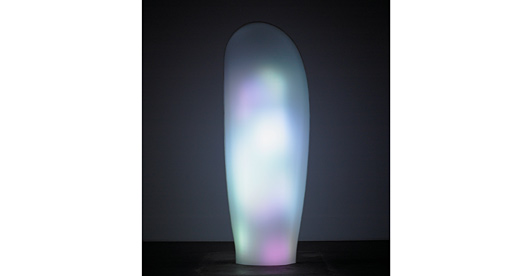
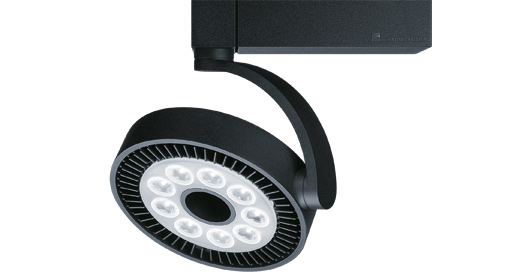
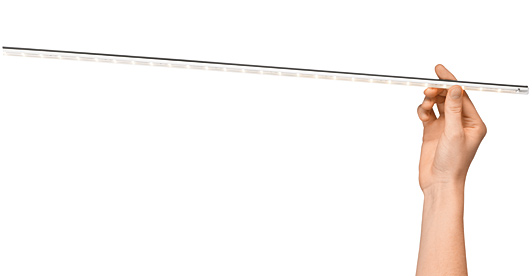
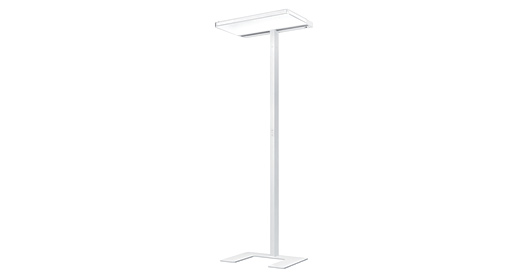
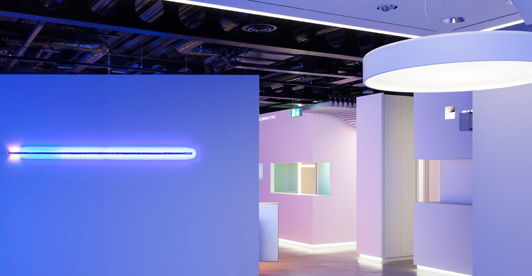





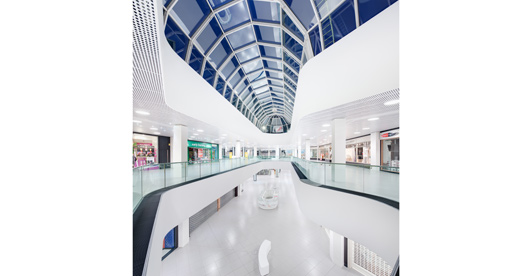







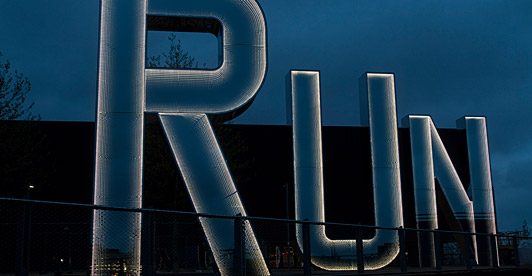
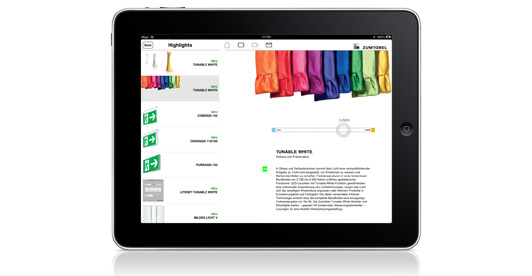


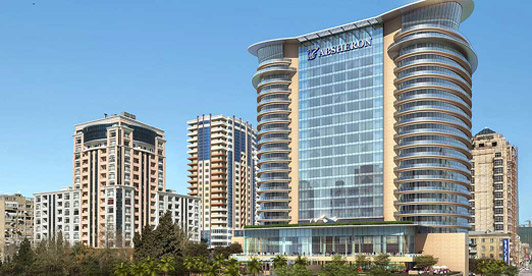



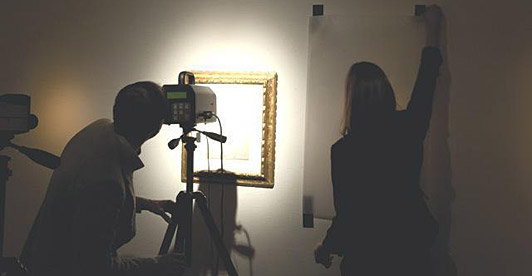

TU_Darmstadt.jpg)
Philipp_Schoenborn_Muenchen_03.jpg)

